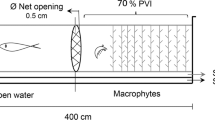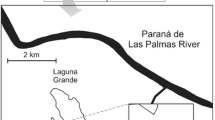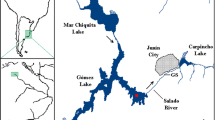Abstract
Neusiedler See, a shallow alkaline lake, has become increasingly eutrophic; this enrichment improved the nutritive situation of the herbivorous zooplankton leading to a higher standing stock. A multiple regression analysis of the long-term development of the crustacean plankton indicates that abiotic factors (i.e. wind, temperature) have the most important impact on the community in spring and autumn, biotic factors (i.e. food, predation) during the summer months. Currently an invertebrate (Leptodora kindti) and two planktivorous fish (Pelecus cultratus and Alburnus alburnus) control the population development of Diaphanosoma mongolianum during summer. L. kindti predation acts on immature stages, whereas the fishes consume adult stages. L. kindti densities of 100 to 200 ind. × m-3 affect the prey population to a negligible extent; densities between 300 and 500 ind. × m-3 result in elimination rates of 5% to >40% of the juvenile Diaphanosoma stock. The impacts by the invertebrate predator are pronounced but short-term events. Juvenile and underyearling fish eliminate 4–13% of the zooplankton in the open lake and 5–33% inshore; their predation pressure acts on all younger stages of the crustaceans. Planktivorous fish older than 0 + concentrate on the large food items (adult stages of the crustaceans). A. alburnus is able to consume 6–16% of the zooplankton standing stock during summer. P. cultratus eliminates about 1–49% of D. mongolianum, 1–4% of A. spinosus and 1–31% of L. kindti. From May until August the position of the dominant predator changes, beginning with juvenile fish which are then followed by P. cultratus and then by A. alburnus. Predation by L. kindti is of importance in July and August; at that time it causes suppression of the juveniles of D. mongolianum, but, on the other hand, the older stages of L. kindti are endangered themselves by the predatory impact of planktivorous fish.
Similar content being viewed by others
References
Azoulay, B. & M. Gophen, 1992. Feeding habits of larval Mirogrex terraesanctae (Steinitz, 1952) in Lake Kinneret (Israel). I. Field study. Hydrobiologia 246: 243–249.
Bobek, M., 1990. Applied hydroacoustics in cyprinid research. Proc. Symp. ‘Fisheries in the year 2000’, Royal Holloway and Bedford New College: 287–297.
Brabrand, A., B. Faafeng & J. P. M. Nilssen, 1986. Juvenile roach and invertebrate predators: delaying the recovery phase of eutrophic lakes by suppression of efficient filter-feeders. J. Fish Biol. 29: 99–106.
Branstrator, D. K. & J. T. Lehman, 1991. Invertebrate predation in Lake Michigan: Regulation of Bosmina longirostris by Leptodora kindti. Limnol. Oceanogr. 36: 483–495.
Browman, H. I., S. Kruse & W. J. O'Brien, 1989. Foraging behavior of the predaceous cladoceran, Leptodora kindti, and escape responses of their prey. J. Plankton Res. 11: 1075–1088.
Campbell, C. E., 1991. Prey selectivities of threespine sticklebacks (Gasterosteus aculeatus) and phantom midge larvae (Chaoborus spp.) in Newfoundland lakes. Freshwat. Biol. 25: 155–167.
Carpenter, S. R. (ed.), 1988. Complex interactions in lake communities. Springer Verlag, New York, 283 pp.
Cryer, M., G. Peirson & C. R. Townsend, 1986. Reciprocal interactions between roach, Rutilus rutilus, and zooplankton in a small lake: Prey dynamics and fish growth and recruitment. Limnol. Oceanogr. 31: 1022–1038.
Cummins, K. W., R. R. Costa, R. E. Rowe, G. A. Moshiri, R. M. Scanlon & R. K. Zajdel, 1969. Ecological energetics of a natural population of the predaceous zooplankter Leptodora kindtii Focke (Cladocera). Oikos 20: 189–223.
de Bernardi, R. & S. Canali, 1975. Population dynamics of pelagic cladocerans in Lago Maggiore. Mem. Ist. ital. Idrobiol. 32: 365–392.
De Vries, D. R. & R. A. Stein, 1992. Complex interactions between fish and zooplankton: Quantifying the role of an open — water plantivore. Can. J. Fish. aquat. Sci. 49: 1216–1227.
Dokulil, M., 1984. Assessment of components controlling phytoplankton photosynthesis and bacterioplankton production in a shallow, alkaline, turbid lake (Neusiedler See, Austria). Int. Revue ges. Hydrobiol. 69: 679–727.
Duncan, A., 1990. A review: limnological management and bio- manipulation in the London reservoirs. Hydrobiologia 200–201/Dev. Hydrobiol. 61: 541–548.
Elliott, J. M. & L. Persson, 1978. The estimation of daily rates of food consumption for fish. J. Anim. Ecol. 47: 977–991.
Gliwicz, Z. M., 1992. Can ecological theory be used to improve water quality? Hydrobiologia 243–244/Dev. Hydrobiol. 79: 283–291.
Gliwicz, Z. M. & J. Pijanowska, 1989. The role of predation in zooplankton succession. In U. Sommer (ed.), Plankton Ecology. Succession in Plankton Communities, Springer Verlag, New York, Berlin, Heidelberg: 253–296.
G. Toth, L., K. V. Balogh & N. P. -Zankai, 1986. Significance and degree of abioseston consumption in the filter-feeder Daphnia galeata Sars am. Richard (Cladocera) in Lake Balaton. Arch. Hydrobiol. 106: 45–60.
Hall, D. J., 1964. An experimental approach to the dynamics of a natural population of Daphnia galeata mendotae. Ecology 45: 94–112.
Hart, R. C., 1988. Zooplankton feeding rates in relation to suspended sediment content: potential influences on community structure in a turbid reservoir. Freshwat. Biol. 19: 123–139.
Herzig, A., 1974. Some population characteristics of planktonic crustaceans in Neusiedler See. Oecologia 15: 127–141.
Herzig, A., 1979. The zooplankton of the open lake. In Löffler, H. (ed.), Neusiedlersee, the limnology of a shallow lake in Central Europe. Dr W. Junk Publishers, The Hague: 281–335.
Herzig, A., 1980. Effects of food, predation and competition in the plankton community of a shallow lake (Neusiedler See, Austria). In M. Dokulil, H. Metz & D. Jewson (eds), Shallow lakes, Contributions to their Limnology. Developments in Hydrobiology 3. Dr W. Junk Publishers, The Hague: 45–51.
Herzig, A., 1984. Temperature and life cycle strategies of Diaphanosoma brachyurum: an experimental study on development, growth, and survival. Arch. Hydrobiol. 101: 143–178.
Herzig, A. & H. Winkler, 1983. Beiträge zur Biologie des Sichlings — Pelecus cultratus (L.). Österr. Fischerei 36: 113–128.
Herzig, A. & B. Auer, 1990. The feeding behaviour of Leptodora kindti and its impact on the zooplankton community of Neusiedler See (Austria). Hydrobiologia 198/Dev. Hydrobiol. 60: 107–117.
Hillbricht-Ilkowska, A. & A. Karabin, 1970. An attempt to estimate consumption, respiration and production of Leptodora kindtii (Focke) in field and laboratory experiments. Pol. Arch. Hydrobiol. 17: 81–86.
Hovenkamp, W., 1990. Instar-specific mortalities of coexisting Daphnia species in relation to food and invertebrate predation. J. Plankton Res. 12: 483–495.
Kerfoot, W. C., 1980. Commentary: transparency, body size and prey conspicuousness. In Kerfoot W. C. (ed.), Evolution and Ecology of Zooplankton Communities. The Univ. Press of New England, Hanover, New Hampshire: 609–617.
Kirk, K. L., 1991. Suspended clay reduces Daphnia feeding rate: behavioural mechanisms. Freshwat. Biol. 25: 357–365.
Kirk, K. L. & J. J. Gilbert, 1990. Suspended clay and the population dynamics of planktonic rotifers and cladocerans. Ecology 71: 1741–1755.
Landau, R., M. Gophen & P. Walline, 1988. Larval Mirogrex terraesanctae (Cyprinidae) of Lake Kinneret (Israel): growth rate, plankton selectivities, consumption rates and interaction with rotifers. Hydrobiologia 169: 91–106.
Leitner, C., 1990. Einfluss von Turbulenz und Trübe auf Diaphanosoma brachyurum (Lievin) (Cladocera, Crustacea) im Neusiedler See. Diplomarbeit, Univ. Wien, 53 pp.
Lunte, C. C. & C. Luecke, 1990. Trophic interactions of Leptodora in Lake Mendota. Limnol. Oceanogr. 35: 1091–1100.
Northcote, T. G., 1988. Fish in the structure and function of freshwater ecosystems: a ‘top-down’ view. Can. J. Fish. aquat. Sci. 45: 361–379.
Paloheimo, J. E., 1974. Calculation of instantaneous birth rate. Limnol. Oceanogr. 19: 692–694.
Persson, L., 1982. Rate of food evacuation in roach (Rutilus rutilus) in relation to temperature, and the application of evacuation rate estimates for studies on the rate of food consumption. Freshwater Biology 12: 203–210.
Post, J. R. & D. J. McQueen, 1987. The impact of planktivorus fish on the structure of a plankton community. Freshwat. Biol. 17: 79–89.
Southwood, T. R. E., 1978. Ecological Methods. 2nd edn. Chapman & Hall, London, 524 pp.
Tatrai, I. & A. Herzig, 1993. The effect of habitat structure on the feeding efficiency of young stages of razor fish (Pelecus cultratus): an experimental approach. Hydrobiologia, in press.
Threlkeld, S. T., 1979. The midsummer dynamics of two Daphnia species in Wintergreen Lake, Michigan. Ecology 60: 165–179.
Whiteside, M. C., 1989. 0 + fish as major factors affecting abundance patterns of littoral zooplankton. Verh. int. Ver. Limnol. 23: 1710–1714.
Wright, J. C., 1965. The population dynamics and production of Daphnia in Canyon Ferry Reservoir. Limnol. Oceanogr. 10: 583–590.
Zurek, R., 1982. Effect of suspended materials on zooplankton. 2. Laboratory investigations of Daphnia hyalina Leydig. Acta Hydrobiol. 24: 233–251.
Author information
Authors and Affiliations
Rights and permissions
About this article
Cite this article
Herzig, A. Predator-prey relationships within the pelagic community of Neusiedler See. Hydrobiologia 275, 81–96 (1994). https://doi.org/10.1007/BF00026702
Issue Date:
DOI: https://doi.org/10.1007/BF00026702




